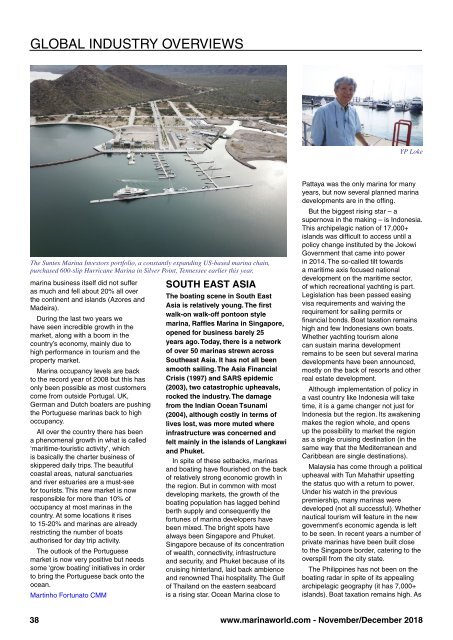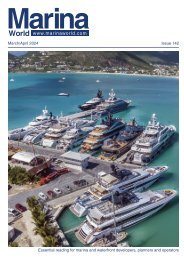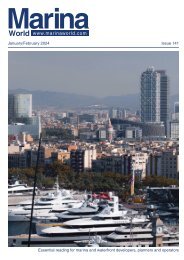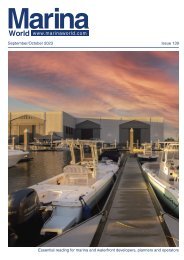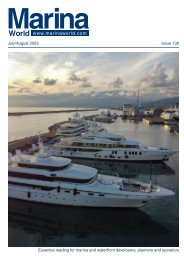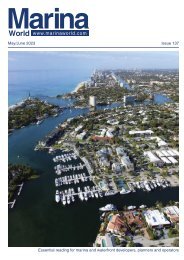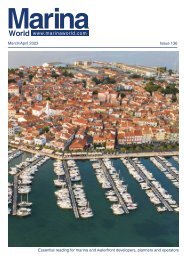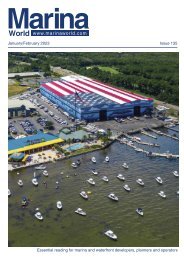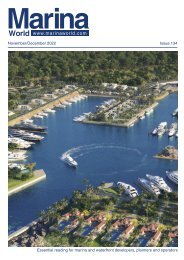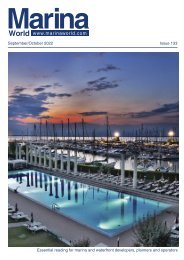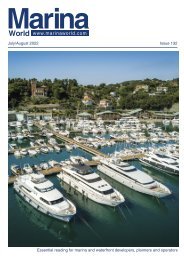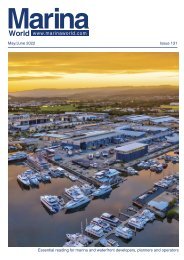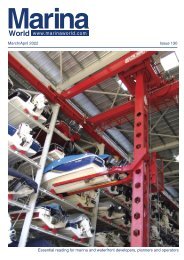You also want an ePaper? Increase the reach of your titles
YUMPU automatically turns print PDFs into web optimized ePapers that Google loves.
GLOBAL INDUSTRY OVERVIEWS<br />
YP Loke<br />
The Suntex <strong>Marina</strong> Investors portfolio, a constantly expanding US-based marina chain,<br />
purchased 600-slip Hurricane <strong>Marina</strong> in Silver Point, Tennessee earlier this year.<br />
marina business itself did not suffer<br />
as much and fell about 20% all over<br />
the continent and islands (Azores and<br />
Madeira).<br />
During the last two years we<br />
have seen incredible growth in the<br />
market, along with a boom in the<br />
country’s economy, mainly due to<br />
high performance in tourism and the<br />
property market.<br />
<strong>Marina</strong> occupancy levels are back<br />
to the record year of 2008 but this has<br />
only been possible as most customers<br />
come from outside Portugal. UK,<br />
German and Dutch boaters are pushing<br />
the Portuguese marinas back to high<br />
occupancy.<br />
All over the country there has been<br />
a phenomenal growth in what is called<br />
‘maritime-touristic activity’, which<br />
is basically the charter business of<br />
skippered daily trips. The beautiful<br />
coastal areas, natural sanctuaries<br />
and river estuaries are a must-see<br />
for tourists. This new market is now<br />
responsible for more than 10% of<br />
occupancy at most marinas in the<br />
country. At some locations it rises<br />
to 15-20% and marinas are already<br />
restricting the number of boats<br />
authorised for day trip activity.<br />
The outlook of the Portuguese<br />
market is now very positive but needs<br />
some ‘grow boating’ initiatives in order<br />
to bring the Portuguese back onto the<br />
ocean.<br />
Martinho Fortunato CMM<br />
SOUTH EAST ASIA<br />
The boating scene in South East<br />
Asia is relatively young. The first<br />
walk-on walk-off pontoon style<br />
marina, Raffles <strong>Marina</strong> in Singapore,<br />
opened for business barely 25<br />
years ago. Today, there is a network<br />
of over 50 marinas strewn across<br />
Southeast Asia. It has not all been<br />
smooth sailing. The Asia Financial<br />
Crisis (1997) and SARS epidemic<br />
(2003), two catastrophic upheavals,<br />
rocked the industry. The damage<br />
from the Indian Ocean Tsunami<br />
(2004), although costly in terms of<br />
lives lost, was more muted where<br />
infrastructure was concerned and<br />
felt mainly in the islands of Langkawi<br />
and Phuket.<br />
In spite of these setbacks, marinas<br />
and boating have flourished on the back<br />
of relatively strong economic growth in<br />
the region. But in common with most<br />
developing markets, the growth of the<br />
boating population has lagged behind<br />
berth supply and consequently the<br />
fortunes of marina developers have<br />
been mixed. The bright spots have<br />
always been Singapore and Phuket.<br />
Singapore because of its concentration<br />
of wealth, connectivity, infrastructure<br />
and security, and Phuket because of its<br />
cruising hinterland, laid back ambience<br />
and renowned Thai hospitality. The Gulf<br />
of Thailand on the eastern seaboard<br />
is a rising star. Ocean <strong>Marina</strong> close to<br />
Pattaya was the only marina for many<br />
years, but now several planned marina<br />
developments are in the offing.<br />
But the biggest rising star – a<br />
supernova in the making – is Indonesia.<br />
This archipelagic nation of 17,000+<br />
islands was difficult to access until a<br />
policy change instituted by the Jokowi<br />
Government that came into power<br />
in 2014. The so-called tilt towards<br />
a maritime axis focused national<br />
development on the maritime sector,<br />
of which recreational yachting is part.<br />
Legislation has been passed easing<br />
visa requirements and waiving the<br />
requirement for sailing permits or<br />
financial bonds. Boat taxation remains<br />
high and few Indonesians own boats.<br />
Whether yachting tourism alone<br />
can sustain marina development<br />
remains to be seen but several marina<br />
developments have been announced,<br />
mostly on the back of resorts and other<br />
real estate development.<br />
Although implementation of policy in<br />
a vast country like Indonesia will take<br />
time, it is a game changer not just for<br />
Indonesia but the region. Its awakening<br />
makes the region whole, and opens<br />
up the possibility to market the region<br />
as a single cruising destination (in the<br />
same way that the Mediterranean and<br />
Caribbean are single destinations).<br />
Malaysia has come through a political<br />
upheaval with Tun Mahathir upsetting<br />
the status quo with a return to power.<br />
Under his watch in the previous<br />
premiership, many marinas were<br />
developed (not all successful). Whether<br />
nautical tourism will feature in the new<br />
government’s economic agenda is left<br />
to be seen. In recent years a number of<br />
private marinas have been built close<br />
to the Singapore border, catering to the<br />
overspill from the city state.<br />
The Philippines has not been on the<br />
boating radar in spite of its appealing<br />
archipelagic geography (it has 7,000+<br />
islands). Boat taxation remains high. As<br />
38<br />
www.marinaworld.com - <strong>November</strong>/<strong>December</strong> <strong>2018</strong>


